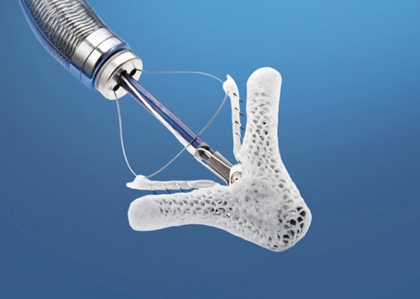Courtesy of Dr. Carlos Fava. Repairing the mitral valve with Mitraclip has become an alternative for high risk or inoperable symptomatic patients, but its long term evolution has only been tested by the EVEREST II, which had not taken into account 5 year mortality outcomes. Therefore, to better study its evolution, we need to carry out different randomized studies…
Post-dilation in TAVI associated to more stroke and more paravalvular regurgitation
Courtesy of Dr. Carlos Fava. Moderate/severe paravalvular regurgitation (PVR) after TAVR is present in 10%-14% of all cases, according to different series. The treatment of choice is post-dilation, generally effective in most cases. However, this strategy carries a risk of stroke. The true impact of this conduct is still unclear. This review analyzed 6 studies that included 5007 patients; 889 of…
Transcatheter valve replacement in the bicuspid valve is increasingly performed, but challenges remain
As experience increases, transcatheter aortic valve replacement (TAVR) has expanded to different populations and anatomies. This study sought to compare technical and clinical outcomes in patients with bicuspid versus tricuspid aortic stenosis from the Bicuspid AS TAVR Multicenter Registry. Outcomes of 561 patients with bicuspid valves and 4546 patients with tricuspid valves were compared. Propensity score matching was used…
Incidence, characteristics, and treatment of valve thrombosis after TAVR
Certain studies have carried out a tomographic follow-up of patients who underwent transcatheter aortic valve replacement (TAVR) and described the frequency of leaflet thrombosis; however, in most cases, it is unclear whether this finding requires some sort of intervention. The difference between this work and those previously published is that this study is not focused on imaging, it…
Progress of patients with hypertrophic cardiomyopathy treated with alcohol septal ablation
Courtesy of Dr. José Álvarez. Alcohol septal ablation (ASA) for the treatment of obstructive hypertrophic cardiomyopathy (OHC) is a procedure introduced in 1995 as an alternative to surgical myectomy. The American College of Cardiology (ACC)/American Heart Association (AHA) guidelines indicate that ASA should be reserved for older patients with comorbidities, thus establishing surgical myectomy…
TAVI without predilation is feasible and safe
Courtesy of Dr. Carlos Fava. Transcatheter aortic valve implantation has already proven to be beneficial for high-risk and inoperable patients. In that sense, it is also an increasingly frequent solid option for lower-risk patients. However, due to the presence of valve calcifications, it may occasionally be necessary to assess the benefits and risks of valve dilation…
SENTINEL study: cerebral protection during TAVR
Neurological complications during and after transcatheter aortic valve replacement (TAVR) are probably the only event whose incidence has not been reduced by new valve designs (as opposed to paravalvular leak, vascular complications, or need for pacemaker implantation). Aside from the potential seriousness of this clinical event, the risk of embolism is particularly worrisome because,…
Transseptal puncture for the treatment of structural heart disease: conventional needle or radiofrequency needle?
Courtesy of Dr. José Álvarez. This study sought to find differences in the transseptal puncture technique between the use of a conventional needle and the use of a radiofrequency-powered needle. A total of 52 patients who underwent transseptal puncture for the treatment of various types of heart disease (Mitraclip, Watchman, Lariat, and mitral valvuloplasty) were…
In-hospital morbid-mortality rates for balloon aortic valvuloplasty are similar to those for transcatheter aortic valve implantation
Courtesy of Dr. Carlos Fava. The balloon aortic valvuloplasty (BAV) was introduced by Dr. Cribier in 1986. However, given its poor results, soon after it fell into disuse. With the introduction of TAVR, it saw a revival as bridge for another intervention, even though it is still resisted in many places. The present study…
Low Gradient Aortic Stenosis Won’t Improve with TAVR
Courtesy of Dr. Carlos Fava. It is known that patients with low gradient aortic stenosis show poor evolution with medical treatment and, in addition, present high mortality rate with surgery. As regards TAVR, a far simpler procedure compared to surgery, there is contradicting evidence; while some studies claim it holds comparable risks, others have found…
Amplatzer and Figulla Devices Prove to Be Safe for Percutaneous Patent Foramen Ovale Closure
Courtesy of Dr. José Álvarez. In patients with presumed paradoxical embolism through a patent foramen ovale (PFO) who are at high risk of recurrent thromboembolic events, percutaneous PFO closure is an alternative to pharmacological treatment. This closure has been shown to be safe and feasible with different devices including various technologies based on an umbrella,…










